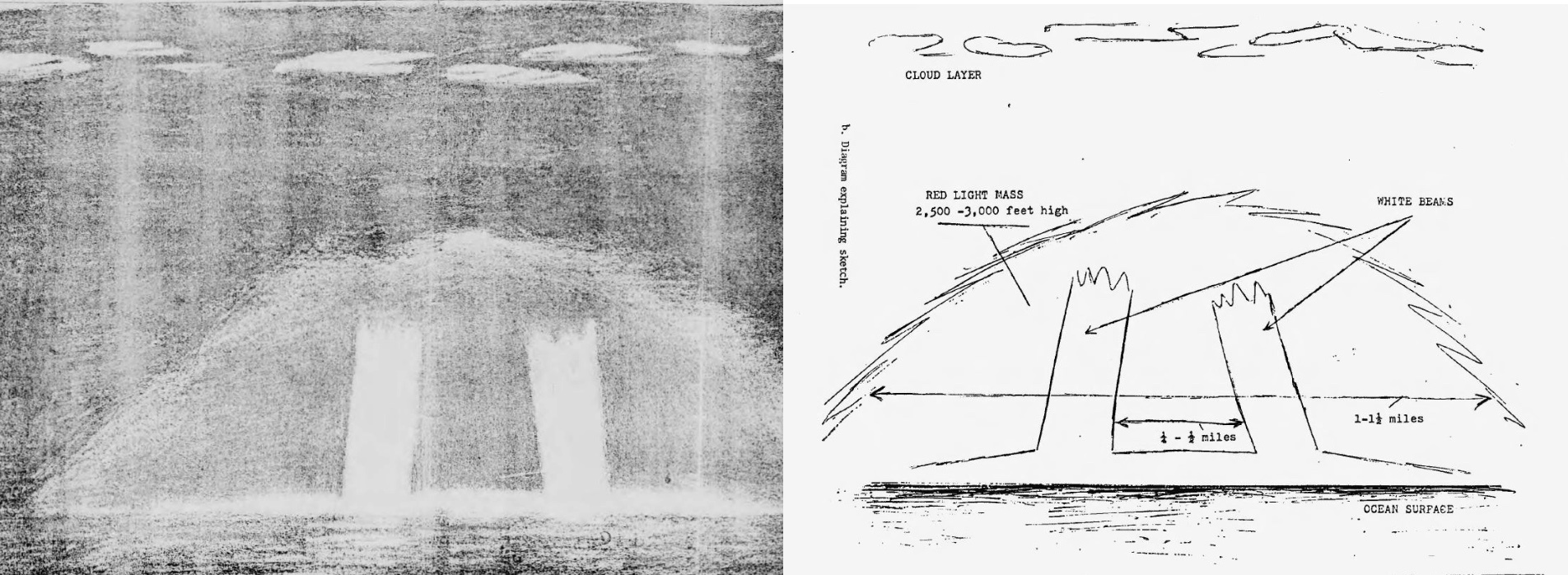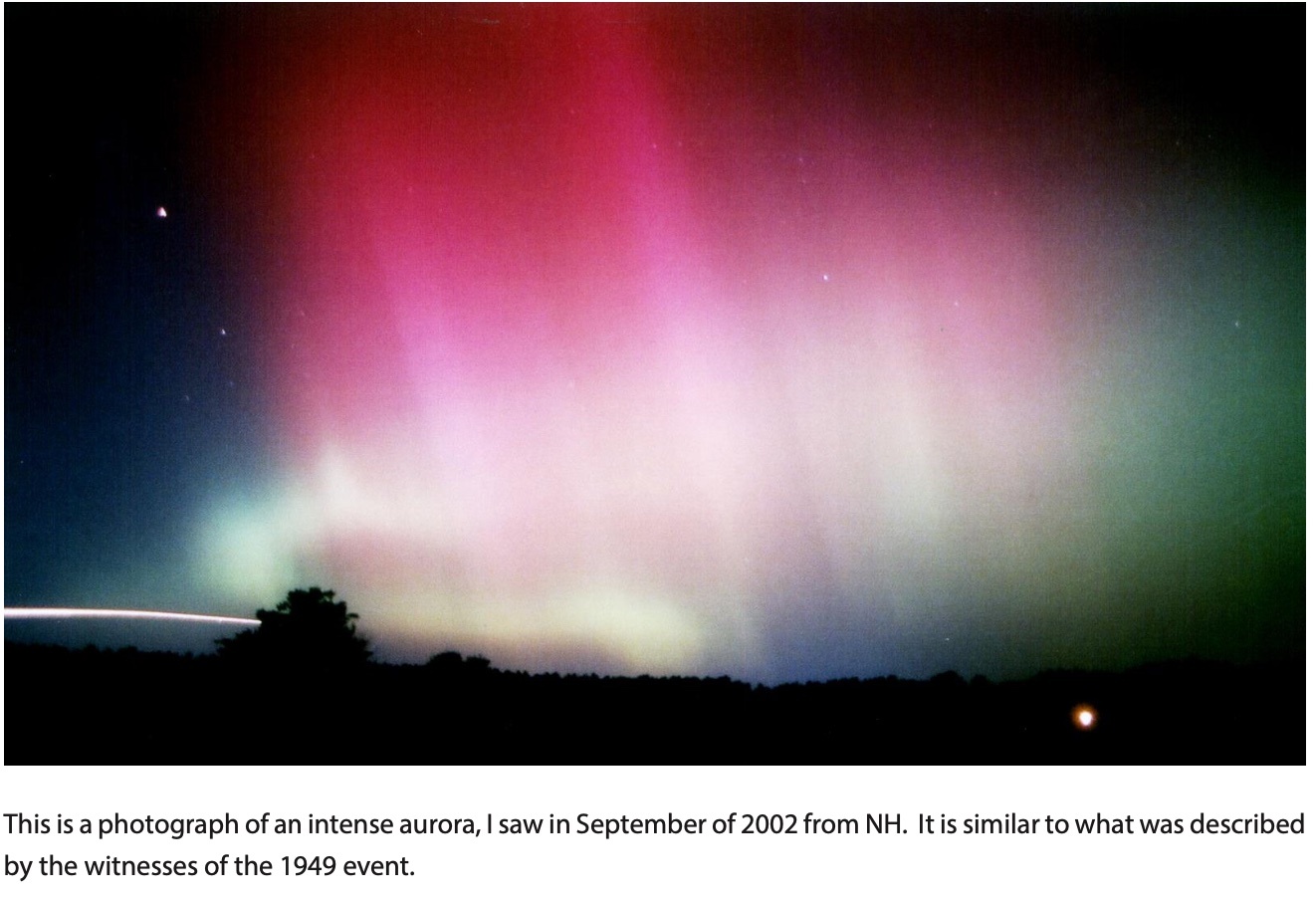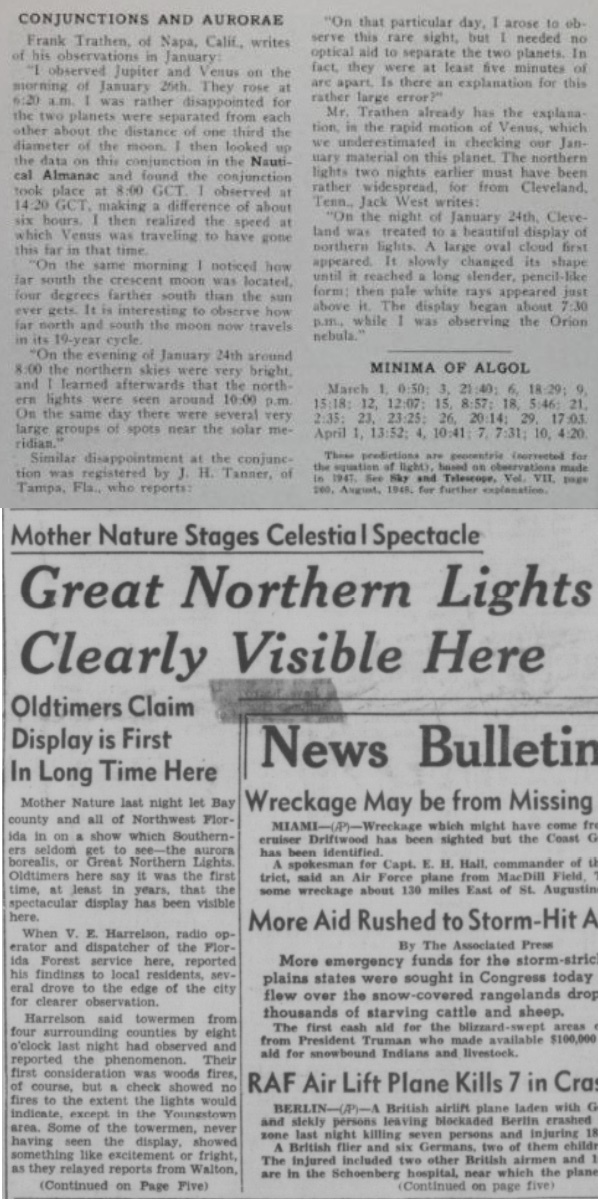21.04.2023

January 24, 1949 - Bermuda

This entry references the Blue Book files, Loren Gross’ UFO history for 1949, and Larry Hatch’s database. Larry’s database is just a listing and provides no information.
Source material
Loren Gross’ account2 reads:
On January 18, 1949, a British Tudor airliner, the “Star Ariel” with 13 passengers and a crew of seven, vanished without a trace 200 miles off Bermuda . A B-29 was dispatched on a special search mission on January 24th . At midnight while cruising at 15,000 feet altitude and at a position of 29 degrees 30 minutes north, 67 degrees 29 minutes west, and on a course of 050 degrees, the pilot of the B-29 perceived a red glow off the left wing. At first the Aircraft Commander, Captain Mattatall thought that the Moon was peeking over the horizon, but after several minutes he was convinced the glow must be something other than the Moon, perhaps even a ship on fire. Intrigued, Captain Mattatall banked in the direction of the red light mass until he brought his plane around to a course heading straight at the crimson patch on the ocean. The pilot later told his superiors:
“On approaching the red light it was observed as a dark red glow, 1 to ll miles wide, based on the water, resembling burning oil with a phosphorescent red light rising to 2,500 to 3,000 feet altitude. Also from heading of 350 degrees and 180 degrees two columns of white light, 1 to i miles apart, resembling searchlight beams and extending upward through approximately 3/4 of the red light mass. The beams were at a slight angle toward each other. Captain Mattatall estimates that if the white light beams had extended above the red light mass to an altitude of 10,000 feet, they would have intersected. It was also observed that the red light mass gave off enough light to illuminate the surface of the water and the bases of surrounding clouds with a dull red glow.”21
Mr. Gross appears to have obtained most of his information from the Blue Book/Grudge files. Gross found one entry that states that Auroral activity was considered but dismissed because there was no auroral activity that night. He appears to have ignored the rest of the file.
The Blue Book/Grudge file contains quite a bit of information.3 Gross spent a lot of his commentary on the 29 April 1949 memo from the Cambridge Atmospheric Physics Laboratory, which stated they could not give an explanation for the sighting and that they had dismissed the possibility that it was the aurora visible that night. However, Gross downplayed the 15 June 1949 memo, from the same office. That memo stated that, after reading an article from “Nature” documenting the Aurora of January 24th, they now concluded that this aurora was the cause of the sighting.
Another detail found in the file is that the time listed by Weinstein is incorrect. It was not midnight but was visible from 2000-2124 local time.
The crewmen were interviewed and their descriptions were pretty consistent:
Staff Sergeant Marx (Engineer) - Red glow resembled a red railroad flare (fuzee) with blue-white base and pillar like beams of varying intensity going up into a red mass. Red mass was transparent and could see stars through it. Stars not visible through white light. Mass appeared to generate its own light, gave off enough light to illuminate water surface and clouds.
Left side scanner - First seemed to be red-gold sunset. Resembled mushroom....Appeared to be coming out of the ocean....Light mass was transparent. Could plainly see water on other side of light...
Co-pilot - Red glow on horizon. Of such intensity that first thought ship was on fire...Main mass of white light based on water, surrounded by red glow which was pierced by two shafts of white light.
Pilot - Appeared to generate its own light, white light comparable to fluorescent light, red light some less brilliant than runway flare..Red light illuminated left wing of A/C and reflected into cockpit...
The case file also mentions that observers in Bermuda also saw the red glow with two shafts of white light and determined it to be an aurora. All crewmen stated they had seen the northern lights before and had never seen anything like this. There are the sketch- es made by the crew of what they saw (See next page).

Analysis
Blue Book/Grudge classified this as Auroral activity and they had good reason for this. The sketches and descriptions are sugges- tive of an aurora. Completely missing from the Gross account is the news article stating the aurora was visible from Bermuda, which was 250-300 miles to the northeast of the aircraft. Only something high in the atmosphere could be seen from two different locations at the same time.
Most important is that the official record indicates Auroral activity was high on the 24th of January. It was so high, that it was seen from the panhandle of Florida (see clipping of Panama City News Journal from 25 January 1949).4 There are plenty of other aurora reports from various states found in the newspaper archives. The March 1949 issue of Sky and Telescope had observations of the Aurora from Cleveland, Tennessee and Napa, California.5 Auroral activity was also visible on the 24th in Yarmouth, UK.6 This indicates that all locations, with clear skies, between western Europe and California had a chance to see an Aurora.


Some of the hesitance by the Cambridge Atmospheric physics laboratory (mentioned by Gross) in classifying this as an aurora are the reports by the witnesses that the glow was on the water’s surface. This was probably an illusion created by the reflection of the aurora on the water’s surface as viewed by an aircraft at 6,000 feet altitude. In that memo, the laboratory seemed to be unaware of the brightness of an aurora that can be seen from southern latitudes. This is understandable since such aurora are rare and probably were not very well documented in 1949. It was not until they read an article in Nature, which
described the aurora seen on the 24th of January 1949, did they conclude that what was seen was this aurora.
All the crew claimed to have seen the northern lights before and what they saw did not appear this way. Aurora that are seen from southern latitudes are often very intense in magnitude and are a deeper red and brighter than aurora only visible from northern latitudes, which are more frequent. Aurora that can only be seen from northern latitudes tend to be dominated by Blue-Green colors and can often be weak in brightness. Any red colors are usually muted or appear pinkish. Only when there is an intense geomag- netic storm, do the colors get extreme. If they had never seen an intense aurora before, one could understand why they would have been surprised by the event they witnessed on January 24, 1949.
Conclusion
There is little doubt that what was seen was an aurora. What was reported had all the characteristics of an aurora and auroral ac- tivity was seen on the date in southern locations in the same hemisphere. Even the island of Bermuda reported seeing an aurora at the time of the sighting. This case, like so many others discussed here, should be removed from the Weinstein list.
Quelle: SUNlite 1/2023
